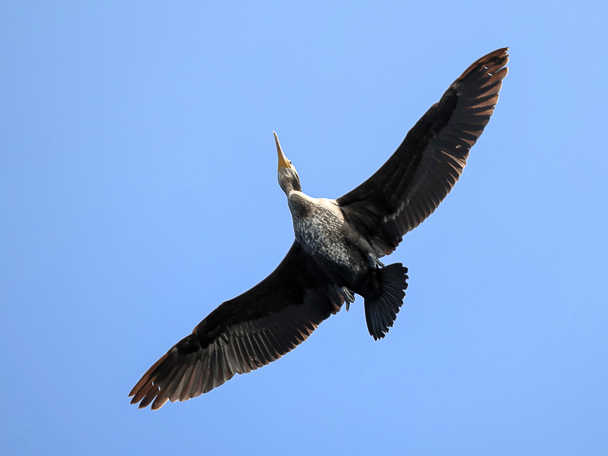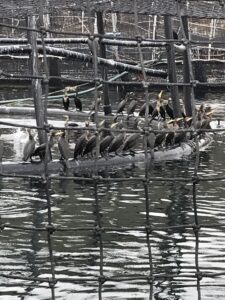Dozens of seabirds killed by salmon company after Tasmanian government approval, documents reveal

The Tasmanian government approved the shooting of dozens of cormorants after substandard netting allowed hundreds of the birds to enter fish cages at a salmon farm near Hobart.
Right to Information documents released to Tasmanian Inquirer revealed that an estimated 641 cormorants entered fish cages at the Sheppards salmon lease near Coningham in November and December 2023.
Thirty-six great cormorants died after becoming entangled in bird netting, and 53 were legally shot by Tassal staff, who had been granted permits by the Department of Natural Resources and Environment.
Gerard Castles, president of the Killora Community Association on Bruny Island, said shooting cormorants was “outrageous”.
“It seems like Orwellian doublespeak that Tassal claims they kill cormorants out of concern for animal welfare,” he said.
Dr Eric Woehler, an independent Tasmanian ecologist who was awarded an Order of Australia medal for 40 years of research on seabirds, said being entangled in netting prevented a cormorant from feeding or drinking and could cause “pain and suffering”.
“It is incumbent on any company to respond as quickly as possible with people used to handling birds to avoid damaging feathers or causing injuries,” he said
Woehler said great cormorants could live for about 20 years and generally mated for life. “From a social licence point of view, it is not a good look to be shooting birds,” he said.
Delayed disclosure
The problem at Tassal’s salmon farm began on November 10, when five cormorants entered one cage. Later that month, another 121 cormorants were found across four of the cages.
The first the department knew of the issue was on December 6, when Tassal submitted a monthly wildlife interactions report. The company’s report said that there had “been no changes in the exclusion infrastructure that could have led to this increased interaction”, but an attached spreadsheet noted that 20 cormorants had entered one cage through a hole in the netting.
“They [Tassal] noted that a cormorant would not move away even if the cormorant sitting next to it was shot”.
Department of Natural Resources and Environment email.
Two days later, Tassal applied for a permit to shoot up to 50 cormorants as large numbers of the birds were squeezing through the 100-millimetre bird netting or weighing down the nets to gain access to the salmon. Tassal estimated that it was losing between $10,000 and $20,000 of salmon per day.
A department officer wrote in a file note on Tassal’s permit application that Tassal wanted to “shoot to scare” the cormorants away and discussed “the need for lethal control on a small number to deter the rest from settling”.
A later file note reported that a Tassal representative had said the “shoot and scare” tactic was ineffective. “They noted that a cormorant would not move away even if the cormorant sitting next to it was shot,” it said.

Great cormorants inside a salmon cage at the Sheppards lease, December 2023. DNRE picture released as part of RTI request.
Woehler said he was not surprised that attempts to scare the birds, including shooting neighbouring birds, were ineffective. “Many birds have become used to loud noises and flashes and have learnt that there is no threat. So gunfire may not scare them at all,” he said.
The department granted the permit but stressed to a Tassal executive that “lethal control of these birds is a last resort”.
Within nine days of being granted the permit, Tassal reported that 36 cormorants had died from entanglement in bird netting. In the week before Christmas, the department granted Tassal a second permit to shoot up to another 30 cormorants. Tassal later reported that 53 cormorants “were humanely culled” at the lease.
In its application for the second permit, a Tassal executive said the company was “installing the correct upgraded exclusion infrastructure”. But they noted that some nets were second-hand, and the company was continuing the “tensioning and repair process”. The records say Tassal replaced the original 100 mm mesh netting with 70 mm mesh nets.
Could it happen again?
The question remains whether a similar event could occur again. Woehler wonders whether the problems at the Sheppards lease were caused by a lack of maintenance or design flaws. “If the issue is the mesh size of the bird nets, is this problem more widespread and occurs at other fish farms?” Woehler asked.
Tassal’s 2022 sustainability report reveals there were 104 bird deaths at the company’s salmon farms in the five years to June 2022. A further 1599 birds were released from inside salmon cages.
Tassal was asked whether it had reviewed its other leases for use of oversized bird netting and other infrastructure flaws, but did not respond.
Tasmanian Inquirer sought copies of department records indicating assessments of risks to birds at other fish farms after the deaths at Sheppards lease. The department said it found no documents.
Gerard Castles said Tassal treated native bird deaths as a cost of doing business. “It’s unacceptable for modern consumers. The department should do a complete, transparent and public audit of all Tassal operations to ensure they use appropriate materials to prevent the deaths of more birds,” he said.
 @BobBurtonoz
@BobBurtonoz